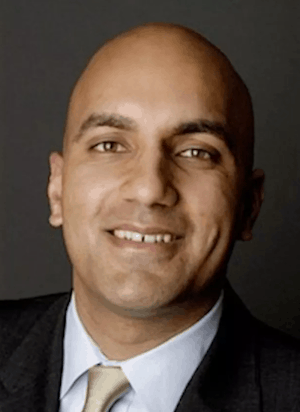‘Not just for profit – but for survival’: CEO Amit Bouri discusses the GIIN’s bold call for all investors to tackle the SDGs
The Global Impact Investing Network (GIIN) made headlines last month when it launched a rather audacious campaign to mobilize investors behind the Sustainable Development Goals (SDGs). In an impassioned (by investing standards) op-ed, GIIN CEO Amit Bouri declared that “this investment is not just for profit – but for survival,” asked that “every investor not already involved make at least one SDG-focused impact investment” – and called on them to start immediately. We spoke with Bouri about this call to action, how to get major investors to heed it – and the challenges and opportunities that will arise if they do.
James Militzer: Some analysts have described this public call-out to investors as an “uncharacteristically activist” stance for the GIIN. Why did you make such a bold move, and why now? Do you see this as a shift in the GIIN’s previous approach to building the sector?
Amit Bouri: Poverty and environmental issues of today require more urgency. In my recent travels, it has been clear that the Sustainable Development Goals (SDGs) are very much on people’s minds. For our part, the GIIN hopes to play a role in providing a bridge between those who know about impact investing but don’t know how it might be applied to the SDGs, and those who know about the SDGs, but don’t understand the contribution impact investing could make to the realization of the goals. Through our campaign, we are working to bring more players on both sides of that bridge together to share knowledge and resources, and consider the importance of collective action focusing on these critical issues.
The one-year anniversary of the U.N. Sustainable Development Goals has provided a natural opportunity to align the investment community with these very important efforts, and for the GIIN to take a more visible leadership role in making this happen. These goals have very broad support from global leaders, and the GIIN is committed to ensuring that impact investors are aware of the contribution they are uniquely qualified to make. Investment capital is too great a resource for positive change to leave it untapped.
We don’t see this as a shift in approach for the GIIN, quite the opposite actually. All of our work is about driving activity that will accelerate the scale and effectiveness of impact investing. The SDGs provide an important and useful global framework for individual impact investors. So far the response to our call to action has been very energizing. GIIN members and groups in our broader network have confirmed their desire to take a bolder leadership role and help set the agenda for the investment community.

Amit Bouri, CEO of the GIIN
JM: The GIIN counts among its members many of the biggest investors and fund managers in the world – how much do you think your advocacy can influence their investment decisions, and beyond this public call, what else will you be doing to get them on board with this campaign?
AB: We’re glad to be a resource for investors of all sizes that are looking at impact investing, and we’re excited that so many large financial institutions are increasingly involved. Our call for them to focus their initiatives more squarely on the SDGs is the latest in our efforts to bring more and more diverse investors into the industry. Impact investing has certainly been gaining momentum, but there are still plenty of investors who have yet to heed the call and may not realize the great number of options available for impact investing programs. We also wanted to address those already involved in impact investing that are interested in the SDGs by providing helpful and tangible guidance as to how to become more closely aligned. So far, the campaign seems to be generating great enthusiasm from our key stakeholders.
JM: You went into some detail in your op-ed about the growing amount of evidence showing that impact investing delivers returns that are comparable to traditional investments. Do you think the biggest mainstream investors fully believe that, and if not, how can they be convinced? And how important will this be to the success of the campaign?
AB: There’s a natural set of questions any investor — large mainstream investors, foundations, and fund managers, alike — should ask when assessing new investments, and impact investments are no different. When we talk to new investors, they tend to wonder about the returns and the opportunities. On the topic of potential returns, the Impact Investing Benchmark report, published last year by the GIIN and Cambridge Associates, was an important milestone because it delivered the hard data that helps to prove the concept of impact investing. This report highlighted that risk-adjusted market rates of return are possible in impact investing. It is clear that this market is growing, and as we continue to build the evidence base, we do expect more institutional investors to join. Of course, not all impact investors are targeting market-rate returns. In our 2016 Annual Impact Investor Survey, 59 percent of respondents primarily target risk-adjusted, market-rate returns. Of the remainder, 25 percent primarily target below-market returns that are closer to market-rate returns, and 16 percent target returns that are closer to capital preservation. It’s important to note that for our campaign to be successful, it will be equally important to add investors of all sizes and types, and for them to work even more collaboratively.
JM: In emphasizing competitive financial returns so heavily, is there any risk that these big investors will focus exclusively on those investments that are most profitable – say microcredit, for instance – at the expense of other companies or sectors that arguably have greater social impact? If so, are you doing anything to encourage these investors to place as much emphasis on social impact as they do on financial returns?
AB: Impact measurement is an essential element of impact investing and the GIIN focuses a great amount on building up the practice of impact measurement and management. We manage IRIS, the catalog of performance metrics for social and environmental impact, and encourage greater sophistication and rigor in impact measurement and management. We have also recently released a report on the Business Value of Impact Measurement, which finds that the act of measuring the social and environmental impact of investments yields important positive business value for investors and investees. As more investors join the industry and they bring their particular focus and preferences to bear, we expect there will be natural shifts in investment flows, with some sectors seeing more activity than others, as we would see in any other market.
JM: Talk about how some leading impact (or even traditional) investors are already framing their investments around the SDGs – do you see any promising models there that other investors could emulate?
AB: There are some great examples of SDG-focused impact investing in action. Part of our campaign includes publishing several profiles of impact investors that are aligned with the SDGs. What is really powerful for investors who have been committed to the SDGs for years is that this alignment provides a clear framework and helps them communicate broader impact. All of the investors that participated offer very positive examples of SDG alignment. One is Triodos Investment Management, a Netherlands-based fund manager that leverages the SDGs as a helpful framework in both communicating with stakeholders and portfolio companies as well as informing its strategy.
JM: What are some of the challenges you expect investors to face in aligning their investments with the SDGs, or assessing whether they’re working? What can the GIIN, or other entities, do to help individual investors, or to guide the broader market so that all SDGs are covered?
AB: The SDGs are an exciting challenge in and of themselves because they are so far-reaching and ambitious. Impact investing is a natural fit for the SDGs, as many impact investors have been working on finding solutions to these issues for years. Our SDG campaign works to help raise awareness among impact investors by helping them view their accomplishments on a global scale, and encourages all investors to get involved. By connecting the diverse universe of investors through the GIIN network and outreach activities, we can help these investors learn from one another and help see how they are contributing to the larger SDG movement. We expect impact investors to be key players in moving the SDGs forward; no other industry is better positioned to tap into the world’s investment capital as a resource for positive change. That said, we understand that some goals may initially attract more impact capital than others, as impact investors have had a longer-term focus in some industries, but we hope in the longer term all of the goal areas will receive the capital they need.
JM: What role do you see for blended finance in addressing the SDGs – how important do you think it will be for private capital and public and philanthropic financing to work together more effectively, and what can be done to help?
AB: With the SDGs in place—and with the enormous size of the problems we still face as a world—the financial world will have a big role to play in scaling solutions to meet the size of the need. Investment capital has to get involved; the SDGs and these issues are too important not to. But impact investors won’t be going it alone. Many impact investors work alongside philanthropic organizations and some even have a philanthropic arm within their own organizations.
Collective action and collaboration will be critical to the achievement of the SDGs, and they provide a great opportunity for investors to demonstrate the power of all kinds of collaborative financial structures. This includes blended capital and potentially innovative products like holding companies, which could provide greater liquidity for investors. Our network is hard at work to explore and test many of these approaches to improving the effectiveness of impact investments and to deploy more capital where it is most needed. In addition to a previously published GIIN report Catalytic First-Loss Capital, we’re continuing to explore ideas involving blended finance through a new working group that is focused on the use of guarantees. This group is looking at the role that foundations and guarantees can play in ensuring more private capital can flow into impactful deals.
JM: Do you think impact-focused businesses will be able to absorb the influx of capital that will come if major investors respond to this campaign? What needs to happen, on the investor side and the investee side, to prepare for this influx?
AB: There is always fluctuation in markets and periods of imbalance where there may be more money looking for deals than there are sourced deals. That’s part of the ebb and flow of any market and we expect an adjustment period when there is a surge of interest among movers of capital. We offer ImpactBase, our searchable, online database of over 400 impact investment funds and products designed for investors, as a way of connecting interested accredited investors with a variety of available impact investment opportunities. As with any market, investors need to develop ways to source deals that work for them and fit their individual needs. Additionally, as investors better articulate their strategies and the market develops, there will be more efficient ways for businesses to find the right type of capital.
Photo: United Nations Building, Bangkok. Credit: Isriya Paireepairit, via Flickr.
James Militzer is senior editor at NextBillion.
- Categories
- Investing
- Tags
- impact investing, SDGs



